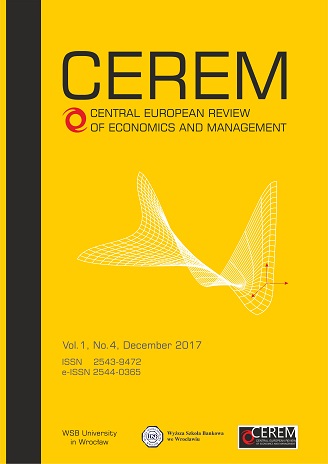Wydajność banków w Arabii Saudyjskiej: ocena wpływu globalnego kryzysu finansowego
DOI:
https://doi.org/10.29015/cerem.580Słowa kluczowe:
Slack based model, metoda obwiedni danych, Arabia SaudyjskaAbstrakt
Cel: Globalny kryzys finansowy z 2008 roku utrudnił funkcjonowanie niemal każdego banku na świecie. Niniejszy artykuł ma na celu ocenę wpływu globalnego kryzysu finansowego na wydajność banków w Arabii Saudyjskiej.
Metodyka badań: Artykuł określa wpływ globalnego kryzysu finansowego na wydajność banków poprzez zastosowanie metody obwiedni danych (ang. data envelopment analysis (DEA)) dla danych z lat 2006-2014. Przebadano 11 komercyjnych banków należących do saudyjskiego sektora bankowego, co stanowiło niemal połowę wszystkich banków w Arabii Saudyjskiej. Aby ocenić wpływ kryzysu finansowego w czasie, uwzględniono wydajność skali, wydajność techniczną oraz produktywność banków.
Wnioski: Na podstawie wyników można stwierdzić, że banki w Arabii Saudyjskiej są niewydajne pod względem wydajności technicznej oraz skali. Ponadto banki te są nieodporne na globalne kryzysy finansowe. Chociaż tylko jeden bank utrzymał swoją pozycję w ramach wydajności jednostkowej, wpływ globalnego kryzysu na wydajność banków jest widoczna w odniesieniu do pozostałych przeanalizowanych banków. Przetestowano także solidność przeprowadzonego badania.
Wartość artykułu: Niniejsze badanie ma podwójne znaczenie. Po pierwsze, przeanalizowano wydajność banków ze szczególnym uwzględnieniem kryzysu finansowego. Po drugie, w Arabii Saudyjskiej należy zapewnić zrównoważony wzrost. Z tego względu określenie wpływu kryzysu finansowego na wydajność banków w Arabii Saudyjskiej z pewnością wesprze decydentów politycznych w przyszłym planowaniu.
Implikacje badań: Wyniki badań zaprezentowane w artykule będą służyć politykom w Arabii Saudyjskiej podczas podejmowania zawczasu odpowiednich kroków w przypadku przyszłego kryzysu finansowego. Co więcej, wyniki będą wykorzystane przez kierowników banków w podejmowaniu decyzji oraz rozwiązywaniu problemów.
Bibliografia
Al-Khathlan K., Malik S.A. (2010), Are Saudi banks efficient? Evidence using Data Envelopment Analysis (DEA), „International Journal of Economics and Finance”, vol. 2 no. 2, pp. 53-58.
Almumani M.A. (2013), The relative efficiency of Saudi banks. Data Envelopment Analysis models, „International Journal of Academic Research in Accounting, Finance and Management Sciences”, vol. 3 no. 3, pp. 152-161.
Charnes A., Cooper W., Rhodes E. (1978), Measuring the efficiency of decision making units, „European Journal of Operational Research”, vol. 2 no. 6, pp. 429-444, DOI: http://dx.doi.org/10.1016/0377-2217(78)90138-8 [10.12.2017].
Charnes A., Cooper W.W. (1959), Chance-constrained programming, „Management Science”, vol. 6 no. 1, pp. 73-79.
Coakes S.J., Steed L.G. (2003), SPSS. Analysis without anguish. Version 11 for Window, John Wiley and Sons, Sydney.
Emrouznejad A., Anouze A.L. (2009), A note on the modeling the efficiency of top Arab banks, „Expert Systems with Applications”, vol. 36 no. 3.1, pp. 5741-5744, DOI: http://dx.doi.org/10.1016/j.eswa.2008.06.075 [10.12.2017].
Emrouznejad A., Parker B.R., Tavares G. (2008), Evaluation of research in efficiency and productivity. A survey and analysis of the first 30 years of scholarly literature in DEA, „Socio-Economic Planning Sciences”, vol. 42 no. 3, pp. 151-157, DOI: http://dx.doi.org/10.1016/j.seps.2007.07.002 [10.12.2017].
Färe R., Lovell C.K. (1978), Measuring the technical efficiency of production, „Journal of Economic Theory”, vol. 19 no. 1, pp. 150-162.
Farrell M.J. (1957), The measurement of productive efficiency, „Journal of the Royal Statistical Society. Series A”, vol. 120 no. 30, pp. 253-290.
Mongid A. (2016), Global Financial Crisis (GFC) and Islamic banks profitability. Evidence from MENA countries, „Journal of Emerging Economies and Islamic Research”, vol. 4 no. 1, pp. 1-16.
Rahman A.R.A., Rosman R. (2013), Efficiency of Islamic banks. A comparative analysis of MENA and Asian countries, „Journal of Economic Cooperation & Development”, vol. 34 no. 1, pp. 63-92, http://www.sesric.org/pdf.php?file=ART12091001-2.pdf [10.12.2017].
Srairi S. (2013), Ownership structure and risk-taking behaviour in conventional and Islamic banks. Evidence for MENA countries, „Borsa Istanbul Review”, vol. 13 no. 4, pp. 115-127, DOI: http://dx.doi.org/10.1016/j.bir.2013.10.010 [10.12.2017].
Sufian F., Akbar N., Mohamad Noor M.A. (2009), The determinants of Islamic banks' efficiency changes. Empirical evidence from the MENA and Asian banking sectors, „International Journal of Islamic and Middle Eastern Finance and Management”, vol. 2 no. 2, pp. 120-138.
Wanke P., Azad M.A.K., Barros C.P., Hassan M.K. (2016), Predicting efficiency in Islamic banks. An integrated multicriteria decision making (MCDM) approach, „Journal of International Financial Markets, Institutions and Money”, vol. 45, pp. 126-141, DOI: http://dx.doi.org/10.1016/j.intfin.2016.07.004.
Wanke P., Barros C.P., Emrouznejad A. (2016), Assessing productive efficiency of banks using integrated Fuzzy-DEA and bootstrapping. A case of Mozambican banks, „European Journal of Operational Research”, vol. 249 no. 1, pp. 378-389, DOI: http://dx.doi.org/10.1016/j.ejor.2015.10.018 [10.12.2017].
Pobrania
Opublikowane
Numer
Dział
Licencja
Autor przenosi nieodpłatnie na Wyższą Szkołę Bankową we Wrocławiu , bez ograniczeń terytorialnych, majątkowe prawa autorskie do tego utworu w rozumieniu ustawy z dnia 4 lutego 1994 roku o prawie autorskim i prawach pokrewnych ( Dz.U. 1994, Nr 24, poz. 83 ze zm. )na zasadzie wyłączności, tj. prawo do:
a) wyłącznego używania i wykorzystania utworu w dowolnej działalności przez Wyższą Szkołę Bankową we Wrocławiu, w szczególności w działalność Biblioteki Cyfrowej uruchomionej przez Wyższą Szkołę Bankową we Wrocławiu
b) wytwarzania, utrwalania i zwielokrotniania egzemplarzy utworów wszelkimi technikami, w tym techniką drukarską, reprograficzną, zapisu magnetycznego oraz techniką cyfrową, w szczególności ich zwielokrotniania poprzez dokonywanie zapisów na płytach typu CD,
c) zamieszczenia wybranych fragmentów utworu w celach promocyjnych w publikacjach, materiałach promocyjnych, w sieci Internet oraz sieciach wewnętrznych typu Intranet Wyższej Szkoły Bankowej we Wrocławiu,
d) wprowadzania utworu do pamięci komputera Wyższej Szkoły Bankowej we Wrocławiu,
e) kopiowania i powielania utworu w technologiach fotomechanicznych lub innych znanych w dniu zawarcia umowy (fotokopie, kserokopie itp.),
f) przetworzenia dzieła na formę elektroniczną i nieograniczonego rozpowszechniania w sieci Internet.


